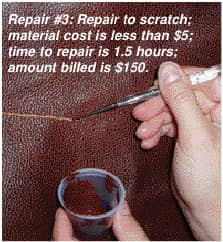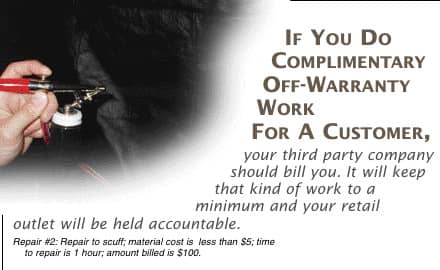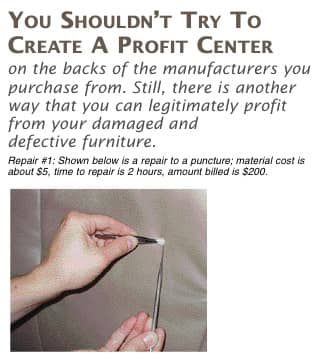Someone stands to profit from your damaged
and defective leather furniture. That “someone” should be you!
Who stands to profit from your damaged and defective furniture? Is it the customer who gets the price discount to keep it? Is it the customer who purchases it at a greatly reduced price from your Clearance Department? Or is it the repair contractor who charges you a healthy sum to restore it to “like new” condition? Someone is likely to profit from your damaged and defective furniture. Why isn’t that “someone” you?
Maximizing Your Potential
Perhaps you believe that your retail operation is doing all it can to deal with damages and defects. You probably already have a good system set up that includes the following five steps that help to limit costs associated with damage and defects.

1) Return Authorizations are sought for major defects and shoddy workmanship not consistent with the quality usually produced by a specific manufacturer.
2) Claims are made against freight companies where obvious shipping and handling mishaps have occurred.
3) The Clearance Department handles old stock that is not moving. It also clears out damaged and defective furniture where credit has already been received.
4) The employed repair staff fixes most repairable damage and defects through one method or another and proper charge-backs are sought.
5) Outside professional contractors are hired to solve repair or cleaning issues not within the capabilities of the employed repair staff. Charge-backs are sought to help reclaim some of the cost of the contractor.
Most retailers rely on at least several of these steps. However, as efficient as a mix of this system could be, are you maximizing your potential? Or are you leaving some money on the table?
The Opportunity
How you look at repairing damaged and defective furniture can be more important than you’ve previously thought. Is it just an annoying operating expense that you find ways to deal with, or can it be an opportunity to add to your business and make money? Can you take your repair department, and convert it from an operating expense to a profit center?
Let’s face it, some retailers try to make their efficient repair departments into profit centers by charging back every little nick and rub - even if it’s a 30 second touch-up. The problem is, however, that this can, and often does, backfire.
Manufacturers can and do “pull the plug” and refuse to honor charge-backs if retailers abuse their privilege. Manufacturers know what percentage of their product will end up being damaged and defective. Beyond that point, the red flag goes up.

Manufacturers should only be held accountable for legitimate damage and defects. You shouldn’t try to create a profit center on the backs of the manufacturers you purchase from. Still, there is another way that you can legitimately profit from your damaged and defective furniture.
This solution may initially seem a bit radical, but it works. It is to set up a repair business that works underneath the umbrella of your parent company.
If you are open to trying this, but you’re hesitant to tackle all aspects of furniture repair at the beginning, start by limiting yourself to leather repair, because leather repair is the most profitable area of furniture repair.
The Benefits
The three main benefits of having your own leather repair business, separate from your retail outlet are: the potential money you can earn, the control over your professional service and your customer’s perception
Having a third party leather repair business has several key benefits:
High Rates: Of all the areas of furniture repair, professional leather repair rates are the highest. Even in comparison to other trades (electrician, plumber, etc.), the rates are high. Check with your repair contractors to see what they charge. In the market I’m in, upholstery contractors charge $50/hour, wood contractors charge $65/hour and leather contractors charge $100/hour. These numbers will vary depending on your market, but the general rule is that leather repair contractors charge more.
You should be able to charge anywhere from $75/hour to $125/hour for professional leather repair.
Good Profitability: Expenses are low. Equipment and supplies are very low per job. Labor costs are reasonable, even for very qualified technicians. And, with the high rates, your profit margins will be wide.
Maximized Charge-backs: Some manufacturers won’t reimburse you, in full, through charge-backs, unless there is proof that a third party performed the work. That’s why you need your leather repair company to bill your retail outlet in an arms-length transaction. Then when you seek charge-backs, you can include a copy of your third party invoice.
Potential Outside Repair Work: Since you’ve set up a leather repair company that is a separate money-making entity, you will be compelled to find ways to ensure that your new company is busy and makes money.
Your leather repair company will be able to perform all sorts of outside repair work. You can get your competitors to pay you to fix their damaged leather furniture. You can also do extended warranty work. And, if you like, you can fix leather problems for private owners of cars, boats, planes and RV’s. The possibilities are numerous, if you are willing.
Whatever you do, though, you need to treat the leather repair company like it is a contracted company. If your retail store decides to have complimentary off-warranty work performed for a good customer, the leather repair company you hire will bill you. It is likely, however, that your in-house repair department would perform the service free-of-charge. Your third party company should send an invoice. That will keep off warranty work to a minimum and your retail outlet will be held accountable.
Control: Your customers are your first priority. They’ve received a first class sales experience, a first class delivery or pick up experience and if they need service, it should be first class, as well.

For in-home service, how can you ensure that your customer receives the same first class treatment from a third party contractor as they would from you? If you own the third party contractor, you can make sure that they pamper your customers.
If you are presently outsourcing your leather calls, you know that you are subject to your contractor’s schedule, their dedication to servicing your customer and your contractor’s trustworthiness.
Often times a contractor will prioritize your customer and your company based on how much work you give them. They are probably most dedicated to whoever is “feeding” them enough “gravy” jobs.
There is also the “trust” factor. Is your contractor trustworthy? Are they performing the work they’re billing you for?
When you own the repair company, you’re in control. You ensure that your customers and your company receive prompt, friendly service from professional technicians dedicated to servicing your customers and your business first, whether the service is in-home or in-shop.
Your Customers’ Perception: There is always going to be the customer that just doesn’t believe that a retail outlet could afford or be willing to pay to keep a specialized professional leather repair technician on staff.
They may think your repair department is made up of low-paid kids with minor repair skills, or that your retail outlet’s in-house repair staff, at best, has limited repair skills.
This type of customer believes that unbiased professional service can only be performed by a third party company specialist. In this situation, perception is reality. You have the answer for this customer. You don‘t need argue with them. You tell them that you‘re calling a professional company. Then you do it!
Higher rates for Leather Repair
There are two main reasons why leather repair technicians can charge more for their service than wood repair technicians and upholsterers.
Thorough professional training can be hard to find and is not cheap. The best leather repair technicians usually own their own businesses and may have paid hefty franchise fees for their knowledge. They usually guard their secrets well. and are definitely not going to give away the tips, tricks and secrets that they have paid so much to learn.
Another reason for high rates is that professional permanent repairs and color matching techniques can be difficult to learn and require patience. Technicians can’t just “wing it” and hope for the best. Without proper training, a technician can easily botch a repair attempt. The significance of professional training is undisputable. It’s almost impossible for someone untrained to identify leather finishes, perform the correct repair specific to that finish and match the color to camouflage the repair area.
Getting a Qualified Technician
Although leather repair is a specialized trade, it can be taught to anyone who’s got a good attitude, is willing to learn, is patient and can readily see colors.
If you already have a technician on staff that has leather repair skills rivaling professional leather repair contractors, you’re ahead of the game. You’re ready to set up a leather repair business right now. Also read Peter Schlosser’s excellent article “Being Held Hostage By Your Repair People?” from the April 2006 issue of FURNITURE WORLD Magazine (posted to the article archives on www.furninfo.com.)
If you have a technician who is in need of professional leather repair training, then book that person for training as soon as you can, and begin reaping the benefits.
Keeping Technicians
There is no reason why you can’t offer the best leather repair service in your market. Once you’ve set up your leather repair company, have a staff of professional technicians, and work is coming in, how do you keep your professional leather technicians from leaving and perhaps competing with you?
You will need to pay them well, offer production bonuses, generous benefits, incentives, and give them room to see their growth potential in the company. This is no different than if you were trying to hang onto any other valued professional.
What do you pay someone who makes you $75/hour - $125/hour in your third party repair business? How valuable are they to you? Only you can answer this.
Keep in mind, that previous to this, you looked at damaged and defective leather furniture like it was only an operating expense. Once you set up an independent company, these same technicians become much more than a $10/hr - $20/hr expense. They can now make you money. They will pay for themselves and your damaged and defective leather furniture repairs.
Everyone Wins
You ensure your customers receive prompt, first class service from the best professional leather repair technicians in town.
With the additional money and benefits your professional technicians receive, you should be able to control staff turnover and keep a stable crew. You can get creative with raises and you won’t have to dread the days when they hit you up for them because you can always raise rates a little or adjust production bonuses. They will be motivated to work and produce for you for years.
Your customers will be happy because they will receive first class service. Your technicians will be happy, so you’ll get stable professional service for many years. On top of it all, you now make a little money where you only had an operating expense before.
Bruce Nurse is Owner / Instructor: Tullus Leather Consulting, Wetaskiwin, Alberta, Canada. His company specializes in helping furniture retailers and repair companies to set up profitable leather repair departments/ businesses and hire/ train repair consultants in leather repair techniques. Questions on any aspect of leather repair can be directed to Bruce at bnurse@furninfo.com.